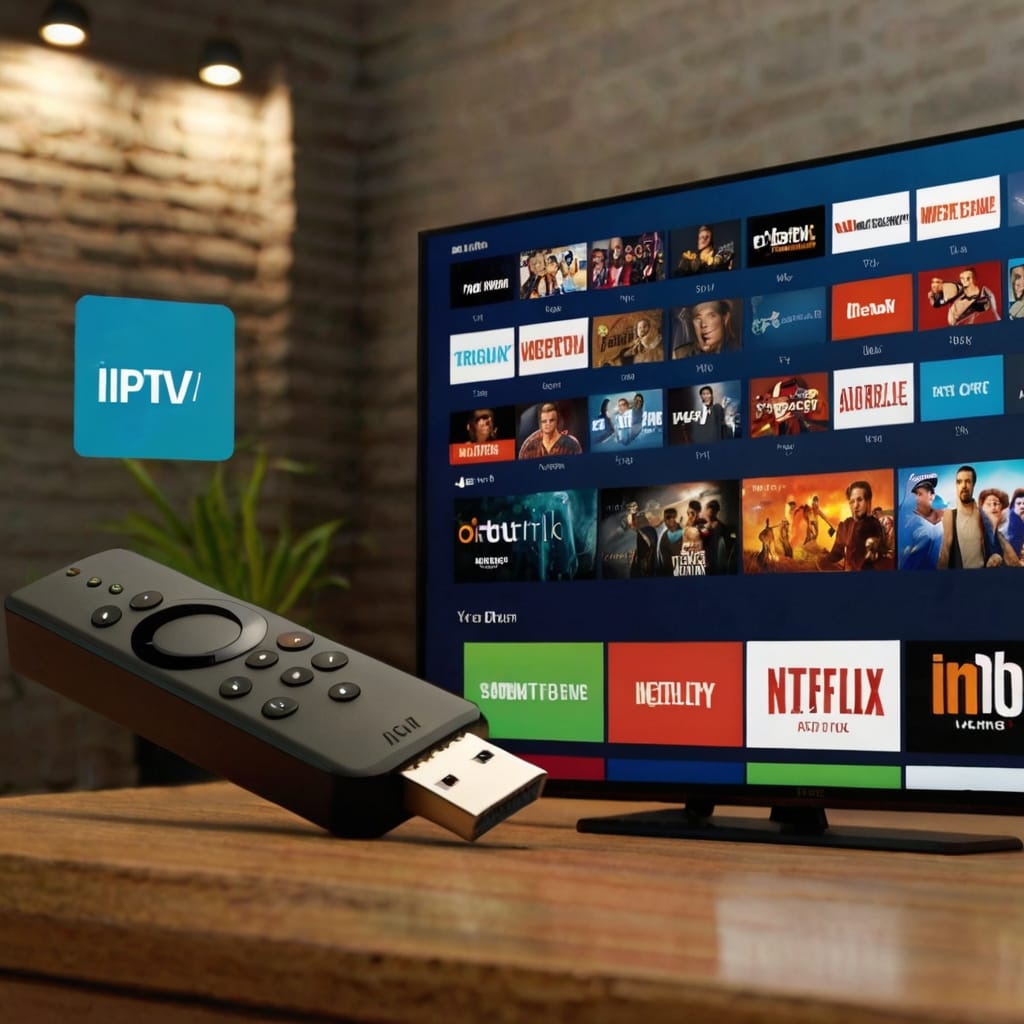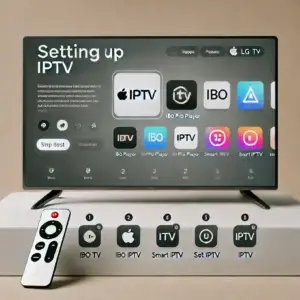“`html
Introduction to IPTV and Its Benefits
Internet Protocol Television, commonly known as IPTV, revolutionizes the traditional way of watching television by delivering content over an internet connection. Unlike conventional broadcasting methods that rely on satellite or cable, IPTV uses internet protocols to stream television channels, videos on demand (VOD), and other multimedia content directly to users’ devices. This technology has transformed the viewing experience, making it more flexible and user-centric.
One of the primary benefits of IPTV is its ability to offer a vast array of channels and on-demand content. Users can access not only standard broadcast channels but also specialized programs tailored to their interests, from niche sports events to rare documentaries. The extensive variety of content available on IPTV platforms surpasses what traditional cable or satellite TV can provide.
Another significant advantage of IPTV is its flexibility. Viewers are no longer bound by network schedules; instead, they can watch their favorite shows at their convenience. IPTV services typically include functionalities such as pause, rewind, and fast-forward, enhancing the overall user experience and allowing viewers to have more control over their viewing habits. This capability makes catching up on missed episodes or rewatching favorite moments incredibly straightforward.
Moreover, IPTV is often more cost-effective compared to conventional broadcasting methods. Many IPTV providers offer customizable subscription packages where users only pay for the channels and services they are interested in, rather than a bundled package that includes unwanted channels. This targeted approach can result in significant savings for consumers.
In summary, IPTV provides a modern, flexible, and more personalized approach to watching television. By leveraging internet protocols for content delivery, it opens up a world of possibilities for viewers, offering them greater choice, convenience, and potential cost savings. As the adoption of high-speed internet becomes more widespread, the appeal of IPTV is likely to continue its upward trajectory.
Identifying Common IPTV Issues
Interactive Protocol Television (IPTV) has reshaped the way we consume media, offering a flexible and customizable viewing experience. However, this modern convenience sometimes comes with its own set of challenges. Some of the most common issues users encounter include buffering, poor video quality, connection problems, missing channels, and login or authentication errors. Identifying these problems is the first step in effective troubleshooting.
Buffering remains one of the most widespread issues affecting IPTV users. This occurs when streaming content pauses intermittently, causing interruptions in the viewing experience. Buffering often results from insufficient internet bandwidth, server overloads, or faulty network configurations. Poor video quality is another frequent complaint. This might manifest as pixelation, lagging, or inconsistent resolution, often caused by low-bandwidth connections or suboptimal server performance.
Connection problems, such as sudden disconnections or the inability to establish a connection in the first place, can stem from network congestion, router malfunctions, or IPTV server issues. Missing channels add another layer of frustration, where users find that specific channels are unavailable despite being part of their subscription package. This problem could be related to service provider restrictions, licensing issues, or outdated IPTV app versions.
Login or authentication errors can further complicate the IPTV experience. These issues typically arise from entering incorrect login details, expired subscriptions, or network security settings blocking access. Incorrect configurations and outdated apps can also contribute to these authentication issues. Understanding these common IPTV problems sets the stage for the troubleshooting steps that follow, allowing users to systematically address each issue for a smoother viewing experience.
Buffering and Lag: Causes and Solutions
Buffering and lag are among the most common challenges faced by users of IPTV services. These interruptions not only diminish the viewing experience but also cause significant frustration. Understanding the underlying causes and implementing appropriate solutions can help ensure a smoother and more enjoyable IPTV experience.
Several factors can lead to buffering and lag, the foremost being insufficient internet speed. IPTV relies on a steady and fast internet connection to stream content seamlessly. Slow internet speeds can cause significant delays, leading to frequent buffering. Network congestion is another potential issue, often occurring during peak usage times. Shared internet connections can become overburdened as multiple devices vie for bandwidth, thereby causing interruptions in streaming service.
Besides these, server problems on the IPTV provider’s end can also contribute to buffering and lag. Overloaded servers, maintenance activities, or technical difficulties can impact the smooth delivery of content to users. Furthermore, using Wi-Fi instead of a wired connection can introduce instability, as wireless signals are prone to interference and can suffer from signal loss over distances or through obstructions such as walls.
Addressing these issues involves several proactive measures. First, users should verify their internet speed by using online speed testing tools. An internet plan with sufficient speed, typically a minimum of 10 Mbps for standard definition streams and higher for HD content, is recommended for a lag-free experience. Boosting overall performance might also necessitate upgrading to a higher-speed plan.
Second, rebooting the router can resolve temporary issues related to network congestion or device memory overload. This simple step can refresh the connection, often leading to improved performance.
For more stable connectivity, adopting a wired Ethernet connection instead of relying on Wi-Fi can significantly reduce lag and buffering. Ethernet provides a consistent and secure connection less susceptible to interference compared to wireless networks.
In sum, analyzing the causes of buffering and lag and implementing effective solutions can greatly enhance the quality of IPTV service, providing users with a more satisfying and uninterrupted viewing experience.
Resolving Video Quality Problems
Video quality issues are a common concern for IPTV users. Problems such as pixelation, blurriness, or poor resolution can significantly detract from the viewing experience. These issues often stem from various sources, including bandwidth limitations, server loads, or outdated hardware.
One of the primary causes of video quality problems is bandwidth limitations. If your internet connection is not robust enough, it might struggle to stream high-definition content smoothly. Ensuring that you have a reliable, high-speed internet connection is crucial. Upgrading to a higher-tier internet plan can provide the necessary bandwidth to handle streaming demands effectively.
Another factor that can affect video quality is server load. During peak times, IPTV servers can become overwhelmed by the number of users accessing content simultaneously, leading to degraded performance and video quality. Although users have limited control over server loads, choosing IPTV providers with reliable infrastructure and sufficient server capacity can mitigate these issues. Consider opting for a service that offers load-balanced servers to ensure a more stable viewing experience.
Outdated hardware and software can also contribute to video quality problems. Ensure that your streaming device’s software is up-to-date to benefit from the latest enhancements and bug fixes. Regularly checking for firmware and application updates can address compatibility issues and improve overall performance. Additionally, using modern streaming devices with advanced processing capabilities can make a noticeable difference in video quality.
Adjusting video settings within the IPTV application is a practical solution for immediate improvement. Many applications allow users to modify the video resolution and buffering options. Lowering the resolution can reduce buffering and improve playback smoothness, particularly when dealing with limited bandwidth. Conversely, if bandwidth is not a constraint, opting for higher resolution settings can enhance the visual experience.
In conclusion, addressing video quality issues in IPTV involves a multifaceted approach. By managing bandwidth effectively, selecting reliable IPTV providers, keeping hardware and software up-to-date, and optimizing video settings, users can significantly enhance their viewing experience.
Fixing Connection Issues
Encountering connection issues with IPTV services is a common experience for many users. These problems can stem from several sources, such as service outages, incorrect configurations, or VPN-related complications. Here we will explore these potential causes and offer solutions to help resolve them efficiently.
One of the primary causes for connection issues is service outages. It is advisable to first check for any notifications or announcements from your IPTV service provider, as they may be experiencing service interruptions. These updates are often posted on the provider’s official website or social media channels.
Incorrect configurations can also lead to connectivity problems. Ensure that your IPTV box or app is properly configured according to the service provider’s guidelines. Double-check the entered server addresses, login credentials, and network settings. Even a minor error in these configurations can hinder a stable connection.
Another common factor affecting IPTV performance is the use of a Virtual Private Network (VPN). While VPNs are useful for maintaining privacy, they can sometimes cause connectivity issues with IPTV services. Temporarily disabling your VPN can help determine if it’s the source of the problem. If the connection improves without the VPN, consider adjusting the VPN settings or using a different server.
Restarting devices is a simple yet effective troubleshooting step. Begin by rebooting your IPTV box or app. Additionally, restarting your internet router can help refresh your network connection, potentially resolving any temporary glitches. Ensure that your devices are connected to a robust and stable internet network, as weak signals can also contribute to connectivity problems.
In summary, addressing connection issues with IPTV involves a systematic approach. By checking for service provider notifications, verifying network configurations, managing VPN settings, and restarting devices, users can often mitigate, if not entirely resolve, these common issues. Consistent troubleshooting can enhance the overall IPTV viewing experience, ensuring minimal interruptions.
Dealing with Missing Channels or Content
One of the recurrent issues users face with IPTV services is the sudden disappearance of channels or specific content. Several factors can contribute to this issue, and understanding these can help in efficiently troubleshooting the problem. Missing channels or content can often be attributed to subscription package limitations, channel removal by the provider, or regional restrictions.
Firstly, it’s vital to verify your subscription status. Ensure that your subscription is active and that your package includes the channels or content you are looking for. Sometimes, IPTV providers offer tiered subscriptions, and not all packages may grant access to every available channel. Additionally, consider that some channels might require a separate subscription or an add-on package.
Secondly, the removal or unavailability of channels by the provider can also result in missing content. Providers may occasionally update their channel lineup due to licensing agreements, operational costs, or strategic decisions. When a channel is removed, there is usually a provider announcement beforehand. Therefore, it is wise to regularly check provider communications, such as emails, official websites, or app notifications to stay updated on any such changes.
Lastly, regional restrictions can play a significant role in the availability of specific channels and content. Certain IPTV services might enforce geo-blocking, which restricts content based on the user’s geographical location. If region-locked content is the issue, using a Virtual Private Network (VPN) can be a solution. A VPN masks your IP address, allowing you to appear as if you are accessing the internet from a different location. Choose a reputable VPN service and connect to a server in the region where the desired content is accessible.
By systematically verifying your subscription details, staying informed about your provider’s announcements, and understanding regional restrictions, you can effectively address issues related to missing channels or content on your IPTV service.
Login and Authentication Errors
Login and authentication errors are among the most commonly encountered issues by IPTV users. These problems can disrupt your viewing experience and can be frustrating if not quickly resolved. However, understanding the common causes and their solutions will help you manage them more effectively.
One prevalent cause of login and authentication errors is the use of incorrect credentials. Whether it’s a typo in your username or an old password, even the smallest error can prevent successful login. Double-checking for accuracy is a simple yet effective first step. If you’ve forgotten your credentials, most IPTV services offer a password reset option. Utilizing this feature can save time and stress.
Another common issue arises from expired subscriptions. Users often overlook subscription renewal dates, leading to unexpected service interruptions. Always ensure that your subscription is active. Most providers send notifications or emails when your subscription is about to expire. Setting up reminders can prevent unintentional lapses in service.
Server authentication problems also account for a share of login difficulties. These issues are typically on the server side and may not be immediately fixable from the user’s end. When server problems occur, you might receive error messages or experience login timeouts. Contacting customer support is the best course of action in such cases. Providing them with detailed information regarding the error messages can expedite the troubleshooting process.
In summary, addressing login and authentication errors in IPTV involves a few fundamental steps—ensuring the correctness of credentials, maintaining active subscriptions, and seeking assistance for server-side issues. By systematically examining these areas, you can resolve most login problems and get back to enjoying your IPTV services without unnecessary interruptions.
Advanced Troubleshooting and Seeking Help
For users who have exhausted basic troubleshooting options to no avail, it may be necessary to take more advanced actions. One crucial step is reinstalling the IPTV app. Uninstalling and then installing the latest version can often resolve glitches caused by corrupted files or outdated software. Make sure to follow the guidelines set forth by your IPTV service to ensure you use the correct version of the app compatible with your device.
Another advanced troubleshooting method involves performing a factory reset on your device, whether it’s a Smart TV, streaming box, or mobile device. Restoring the device to its original settings can sometimes alleviate persistent issues. Remember to back up any valuable data, as a factory reset will erase all installed apps and personal settings. Reconfigure your IPTV service as per the initial setup instructions after the reset.
For pinpointing issues, dedicated diagnostic tools can be beneficial. Some IPTV services provide proprietary diagnostic tools that can scan for problems, generate reports, and offer targeted advice. Ensure you follow the recommendations provided by these tools for optimal results.
If these steps do not fix the issue, contacting the IPTV provider’s customer support is advisable. When reaching out for assistance, be well-prepared to describe the issue comprehensively. Include specific details like error messages, steps you’ve already taken, and the exact moment when the problem occurs. These details can help customer support quickly identify the root cause and provide an effective solution.
Communication with tech support is key. Be courteous and patient, as these professionals aim to resolve your issues efficiently. Whether through email, chat, or phone, clear and concise communication can expedite assistance and resolve your IPTV issues more effectively.
Conclusion and Preventative Tips
In our detailed guide on troubleshooting common IPTV issues, we explored various facets of addressing potential problems users may encounter. We provided step-by-step approaches to diagnose and solve issues ranging from buffering and connection errors to hardware malfunction and compatibility concerns. Implementing these strategies can significantly enhance your IPTV experience and ensure smoother streaming.
Preventive measures play a crucial role in minimizing future IPTV complications. Regular device maintenance should be at the forefront of these measures. Routinely cleaning hardware, ensuring proper ventilation, and securing connections can mitigate many physical issues. An essential habit is to keep all software up-to-date, including firmware for your devices and the IPTV app itself. Software updates often contain critical patches, performance improvements, and new features that can resolve previously reported problems.
Investing in quality hardware is another preventative action that can improve overall IPTV functionality. Compromising on the quality of set-top boxes, routers, or even HDMI cables can lead to subpar performance and frequent issues. High-quality, reliable hardware often comes with better customer support and warranties that can save time and money in the long run.
Lastly, the cornerstone of a seamless IPTV experience is a reliable and fast internet connection. Streaming requires consistent bandwidth, so investing in a high-speed plan from a dependable ISP is crucial. Regularly testing your internet speed and ensuring your network is optimized for streaming can preempt most connectivity-related disturbances. Staying informed about updates from your service provider can also help in pre-empting and managing any potential issues.
By adhering to these preventative tips—regular maintenance of devices, keeping software updated, investing in quality hardware, and ensuring a reliable internet connection—you can greatly enhance your IPTV experience and minimize the likelihood of future problems. In this fast-evolving digital age, staying informed and proactive is key to enjoying uninterrupted streaming entertainment.





